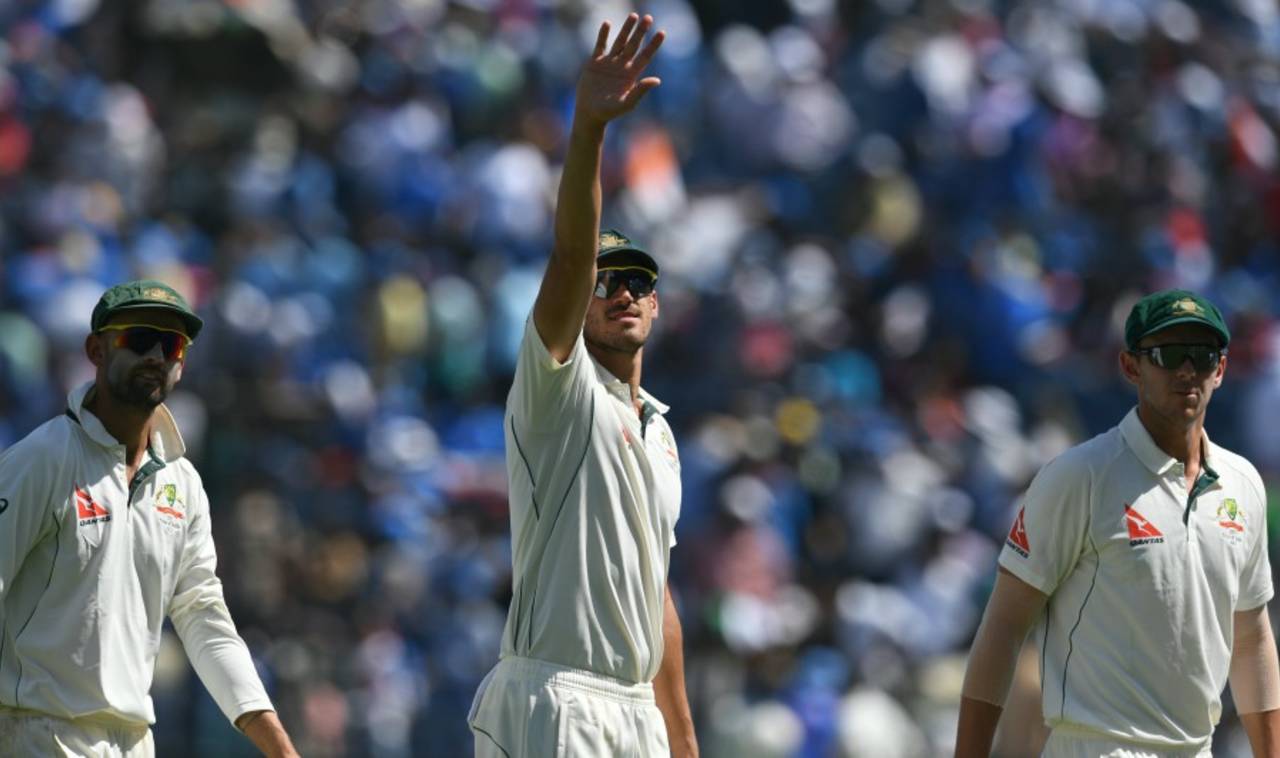Starc showed why he is the best fast bowler
Aakash Chopra analyses Mitchell Starc's short and devastating spells on the second day
Aakash Chopra
24-Feb-2017

Mitchell Starc bowled only nine overs, but the agenda was clear every ball - take wickets • AFP
He bowled only nine overs and that too in three spells of three overs each but that was more than enough to ascertain why Mitchell Starc is considered the best fast bowler in the world. His economy rate of 4.22 runs per over (in an innings where 2.6 per over was the norm) might suggest that he leaked runs and, perhaps, wasn't as penetrative in spite of the two wickets that he picked; but the fact is something else. Runs were leaked because he bowled every ball with a single-point agenda of picking wickets and that meant bowling it a yard fuller, which in turn led to runs being scored. To know what he brought to the table, you must watch every single ball of the nine overs he bowled.
With the new ball

Mitchell Starc's speed barely dipped below 90mph during his nine overs•ESPNcricinfo
It wasn't surprising to see that Starc cranked up the pace right from the beginning, for that's his strength. He's one of those rare fast bowlers who don't have to bowl at 75-80% of optimum pace to find swing, and he did find early swing. KL Rahul flicked him for a boundary off the fourth ball of his first over and even though it looked an easy shot to execute, it conveyed the hidden message - be wary of the full ball that will tail back in. The moment a left-arm fast bowler brings the ball into the right-hander, the batsman becomes cautious of two things - making sure that the front foot doesn't go too far across, and making sure to play it late.
2.1. Starc to Rahul. Driven through covers for four
While the focus is on keeping the front-foot stride short, the natural angle taking the ball away brings about the second challenge. A few balls later, Starc slanted it away from Rahul and pitched it full. To Rahul's credit, in spite of the threat of the incoming delivery, he went out with a long stride and drove it through covers. Top shot.
2.2 Starc to Rahul. Slightly wider. Rahul plays and misses
After getting driven for a boundary, Starc pushed the next one slightly wider luring Rahul to have a go again. Since he had hit the previous ball for a four and the line of this one wasn't too wide, Rahul went for another expansive drive. He played and missed.
2.6 Starc to Rahul. Wide and full, Rahul lets it go
Starc pushed it really wide to finish the over but this time Rahul saw the ball starting from way outside off and therefore, left it alone. As a batsman, you create an imaginary line slightly outside off, because anything that starts from outside of that line is likely to slant across with the angle. They say that to judge a good fast bowler, you must look at his speeds for the full ball. A lot of fast bowlers are sharp with the short ball but not so much with the fuller deliveries. Starc is different. Therefore, batsmen get sucked into playing at deliveries that are leaving them.
Bowls a little short, angling away, Vijay leaves. Same ball consumes Pujara

Mitchell Starc's pitch map on the second day•ESPNcricinfo
Starc dragged the length short, angled it away from M Vijay who shouldered arms to let it go to the wicketkeeper harmlessly. It looked like an innocuous delivery when handled well. But the same delivery consumed Cheteshwar Pujara a few overs later. Starc's pitch map suggests that he either bowled really full or reasonably short, for he had realised that the good length on this surface could be negotiated easily. The short, climbing ball - not short enough to be ducked under - pitched on leg stump and forced Pujara to play at it. The angle kept taking the ball away from Pujara and the bounce didn't allow him to either drop his wrists or shoulder arms, and he ended up gloving it to the wicketkeeper.
Two balls later…
Starc bowled fast and wide. Virat Kohli couldn't resist having a go and edged it to slips. It almost felt like the ball was a magnet and Kohli's bat was made of iron. And it happens often to a batsman in the early part of his innings - the bowler has already found his bearings, while the batsman is still looking around. But a little detail about the ball that got Kohli might have gone unnoticed. The ball was reversing, the shine was facing midwicket but the ball didn't follow the plan. Instead of coming back in, it rocketed away from Kohli. Perhaps, it was just a decoy and served its purpose. Whatever it was, it did show Starc's class. In this series, Kohli v Starc is one of the battles to watch out for and the first round has gone to the bowler.
Aakash Chopra is the author of three books, the latest of which is The Insider: Decoding the craft of cricket. @cricketaakash